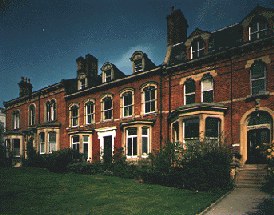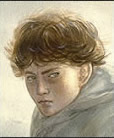Leeds and Professorship

After he returned from the War, Tolkien was offered a lectureship in the English Department of Leeds University, which he happily accepted.
He initially travelled to Leeds on his own as Edith was too heavily pregnant to travel. During that time, he lived in a bedsit during the week and travelled down to Oxford at the weekends. After Michael Hilary Reuel was born, Edith came up to Leeds at the start of 1921, and Tolkien found his family temporary furnished rooms to live in. However, by the end of 1921, they had found a house to rent – albeit it a small, gloomy house – at 11 St Mark’s Terrace. The area was dingy and industrial. Chemicals in the air rotted the curtains within six months, and if Michael was left out in his pram for any length of time, he would get brought back in covered in sooty smuts.
The English Department
The English Department was small, but George Gordon, the Professor of English, was trying to build it up. Leeds had recently split the English curriculum into two – Linguistics and Literature, and soon Gordon handed to Tolkien the responsibility for running the Linguistics side – which basically comprised all the Anglo-Saxon and Middle English courses.
During his first term in Leeds, Tolkien was invited to submit his name as a candidate for two professorships of English Language – the Baines Chair at Liverpool and the newly created De Beers Chair in Cape Town. In January 1921, Tolkien was offered the position in South Africa. He would have dearly liked to accept the position, as he had always wanted to see the country of his birth again, but Edith and the baby were in no fit state to travel and he refused to go without her. Reluctantly, therefore, Tolkien declined the invitation.
He worked for some time at a glossary for a book of Middle-English extracts that Kenneth Sisam had edited. In effect, this meant creating a short Middle-English dictionary, a task which he took on with his normal care, efficiency and imagination. This reached print in early 1922, and he felt that he was ready to turn his hand to something with a greater impact.
In 1922, George Gordon left Leeds to return to Oxford as Professor of English Literature and Tolkien was a candidate for his replacement. However, when Lascelles Abercrombie was appointed instead, Michael Sadler (the University Vice-Chancellor) promised Tolkien that the University would soon create a new Professorship of English Language especially for him.
Eric Valentine Gordon
In early 1922, a new junior lecturer joined the language side of the department. He was EV Gordon, a Canadian, and one of Tolkien’s ex-tutees in Oxford. Soon he and Tolkien began to collaborate on a major piece of scholarship – a new edition of the Middle English poem “Sir Gawain and the Green Knight”. This represented a major contribution to the study of mediaeval literature, though Tolkien later would often make disparaging remarks about their interpretations in the edition. The work was ready for publication by the Clarendon Press early in 1925.
EV Gordon shared Tolkien’s sense of humour and together they helped found the Viking Club among the Leeds undergraduates which met to drink beer, read sagas and sing comic songs – most of which were written by Gordon and Tolkien. Several of these efforts were printed privately some years later as “Songs for the Philologist”. Gordon and Tolkien’s efforts and rapport with the students made them popular, and coupled with their excellence in teaching, they helped make the language side of the department thrive.
Home life in Leeds
Home life for the Tolkiens’ was generally happy. They were saving up to buy a house, so holidays were few. However, they did manage some weeks at Filey in the summer of 1922. Tolkien did not like it there, calling the town “a very nasty little suburban seaside resort”. While he was there, he still had to spend much of his time marking School Certificate papers – a chore he undertook annually to earn some extra money. While there, however, he also created “Roverandom” for John and Michael.
Michael lost his favourite lead dog on the beach one day, and to console him, Tolkien invented the adventures of Roverandum, about a little dog sent by a wizard up the moonpath to meet the Man in the Moon. Many years later, in 1937, he offered this story to his publishers as a successor to “The Hobbit”. It was not thought suitable at the time, and he did not offer it again. Roverandom only saw the light of day in print after Tolkien’s death.
Tales and Songs of Bimble Bay
Over the early years of the 1920s, Tolkien had been composing a good deal of verse, much concerned with his mythology. Some found its way into print in the Leeds University magazine “The Gryphon”, others into a local series called “Yorkshire Poetry”, and yet more into a book of verses by members of the English Department called “Northern Venture”.
He then began a series of poems called “Tales and Songs of Bimble Bay”, which would start addressing a number of issues later seen in Lord of the Rings, as well as introducing a number of familiar-sounding characters. “The Dragon’s Visit” told of the ravages of a dragon who arrived at Bimble Bay and encountered a Miss Biggins. “Glip” described a strange slimy creature with pale luminous eyes who lived beneath the floor of a cave. Another was full of complaints about the sordid noisy character of modern urban life.
Evesham

In May 1923, Tolkien caught a severe cold that turned into pneumonia. While he was recovering, the family went to stay with Hilary on his farm near Evesham. This was also near his Aunt Jane’s farm in Worcestershire, a place the locals called Bag End.
The sojourn on the farm was a time of peace for Tolkien. The whole family were pressed into service to help on the land, they played with kites, and Tolkien managed to devote time to his mythology. “The Book of Lost Tales” was nearly finished. While in Leeds and Oxford, Tolkien had written the stories of creation, the fashioning of the Silmarils and their theft from Valinor by Morgoth, and the cycle lacked only a clear ending. He had only to write the story of the voyage of Earendel’s star-ship, and flesh out some of the stories, and the work would be done. But he did not do this, choosing instead to rewrite the work completed so far. It was as if he did not want to finish the work – partly from a desire for perfection and partly from the desire not to “finish” – not to let go of his creations. This little problem of letting go had been summed up many years before by Christopher Wiseman:
“Why these creatures live to you is because you are still creating them. When you have finished creating them they will be as dead to you as the atoms that make our living food.”
Tolkien began to rewrite two of his major stories as poems. For Túrin he chose a modern equivalent of a type of alliterative measure found in “Beowulf”, while for Beren and Lúthien, he worked in rhyming couples. This work eventually turned into “The Lay of Leithian”.
Professor Tolkien
In 1924, at the very early age of 32, Tolkien became a professor. Soon after he bought a house on the outskirts of Leeds at 2, Darnley Road, West Park. This was of much greater size than the family’s previous houses, and was surrounded by fields where Tolkien could walk with his children.
In November 1924, Christopher Reuel Tolkien was born, and he soon became an especial delight to his father.
Soon after Christopher’s birth, the Rawlinson and Bosworth Professorship in Anglo-Saxon became available in Oxford, and it was soon clear that the two major candidates were Tolkien and his old professor, Kenneth Sisam. Both had a number of supporters. After a tight vote, Tolkien was awarded the position and in early 1926, the family moved back to Oxford.









